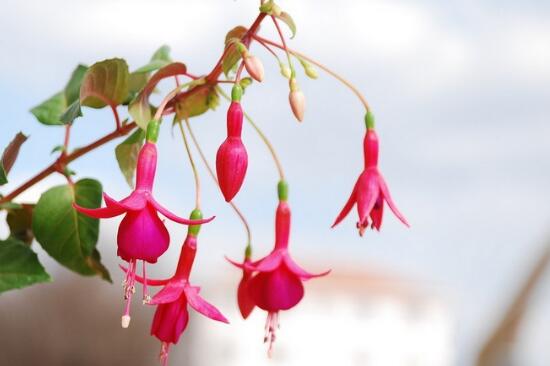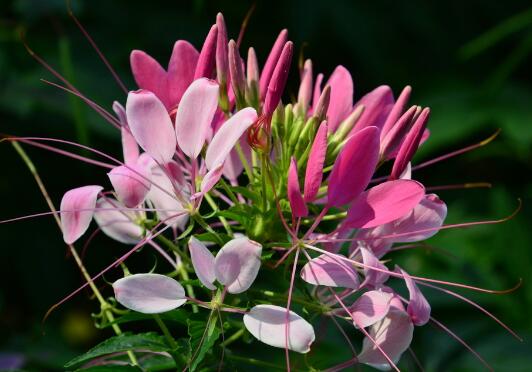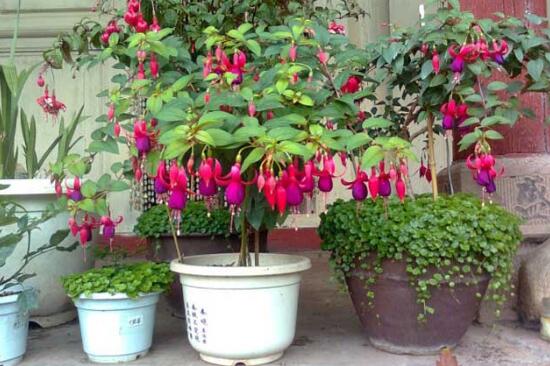How to raise lantern flowers, breeding methods and precautions of lantern flowers / summer semi-overcast maintenance
Lantern flower, as its name is a flower that looks like a lantern, it looks delicate and beautiful, and the color is rich, it looks really beautiful from afar! In life, many flower friends will choose to raise a pot of lantern flowers, then how to raise lantern flowers? The following are the breeding methods and precautions of lantern flowers carefully arranged by the editor, which are very detailed. Friends who want to raise them must take a look at them.
First, how to grow lantern flowers and understand their habits

Lantern flower sex likes cool, moist environment, growth process still needs sufficient light, but it avoids strong light, can shine all day in winter, summer should be properly shaded. As for the soil, it is required to be loose, permeable and well drained. So how to raise lantern flowers is actually very simple to meet its growth habits. Let's move on to the specific requirements.
II. Culture methods and matters needing attention of Lantern Flowers
1. The soil is loose and fertile
How to raise potted lantern flowers, we should first choose soil. Although you go to the flower shop or buy potted plants online, there is existing potted soil, but the soil is not good. If you want lantern flowers to grow well, you'd better choose the soil again.
Soil selection: according to the growth habits of Lantern flower, its cultivation substrate is suitable to choose loose and fertile sandy loam with good ventilation and drainage.
2. Light, semi-overcast in summer
Light is the key to plant growth, and it also plays a vital role in the cultivation of lantern flowers. Lantern flowers like light and need enough in the growth process, so in indoor breeding, spring and autumn are maintained under astigmatism, semi-overcast in summer, and all-day sunshine in winter.
Note: Lantern flowers need sufficient light, once the lack of light, it is easy to cause plant overgrowth, while the number of flowers will be greatly reduced. In addition, lantern flowers avoid strong light, once directed by the strong light, it will cause the leaves to curl. Therefore, when breeding indoors, we should put lantern flowers on balconies, windowsills and other places with good light.
3. Temperature, 15-25 ℃
How to raise lantern flowers, temperature is also a link that can not be ignored. Lantern flowers like a cool environment, the most suitable growth temperature is 15-25 ℃, flower friends want lantern flowers to bloom, it is best to keep this room temperature.
Note: Lantern flowers avoid high temperature, the temperature is more than 30 ℃, the plant will enter a semi-dormant state; lantern flowers are not hardy, once the winter temperature is lower than 5 ℃, it is easy to freeze injury, so in order to survive the winter safely, we should keep the winter room temperature above 10 ℃.
4. Watering, dry and wet
Water is the source of plant life, so watering is very important in the cultivation of lantern flowers. Lantern flowers like the humid environment, we should keep the basin soil moist during the growing period, and adhere to the watering principle of "dry and wet". Water every 2-3 days in winter and rainy season, and once a day in autumn and sunny days.
Note: high temperature in summer, lantern flowers in a semi-dormant state, at this time to control moisture to prevent defoliation, root rot phenomenon. In addition, the pot soil should not be too dry or too wet during the flowering of lantern flowers, otherwise it is very easy to cause buds, flowers or leaves and so on.
5. Fertilization, 7-10 days per time
How to grow lantern flowers? After watering, let's take a look at fertilization. It is understood that lantern flowers grow fast and blossom continuously, so sufficient nutrients are needed in the breeding process. During the growing period, lantern flowers should be given cake fertilizer or dilute liquid fertilizer every 7-10 days.
Precautions: sufficient organic fertilizer is applied before planting, nitrogen fertilizer is controlled in the early growth stage to prevent overgrowth, and it is appropriate to increase the application of phosphorus and potassium fertilizer during lantern flowering.
6. Pruning
In the process of lantern flower growth, in order to maintain its ornamental, proper pruning is very important. At the right time, all the thin and weak branches, withered and yellow branches should be trimmed off, and the remaining branches should be cut short, and the length left behind should be determined by ornamental nature, requiring the whole plant to be coordinated.
7. Change soil
In a suitable environment, lantern flowers will grow very fast, so the soil requires fertile soil. However, with the continuous absorption of the plant, the pot soil of the lantern flower will gradually become barren, so in the process of growing the lantern flower, the flower friends should change the soil once a year to replenish nutrients.
How to raise lantern flowers, breeding methods and matters needing attention of lantern flowers
Lantern flowers give people a beautiful and festive feeling, its flowers, such as hanging color lanterns, can be used for potted viewing, lantern flowers are mainly used in guest rooms, flower racks, desk embellishment, with water vase, not only can be watched, but also can take root and reproduce. Many people do not know how to raise lantern flowers, the following is to introduce the breeding methods and points for attention of lantern flowers.
Culture methods of Lantern Flowers
Lantern flowers produce few seeds and often rely on cuttings for propagation. Lantern flower is mainly propagated by cuttage, which is cut in January, February and October. The optimum cutting temperature is 15 ℃ 20 min, and rooting takes about 20 days. Cutting 5-8cm, the growing tip is used as cuttings. When the temperature is 20 ℃, the shoots will take root two weeks after cutting, and pot in time after rooting, otherwise the roots are easy to rot. Permanent cuttage propagation can be used all year round, and it can take root faster in spring and autumn. Cuttings with top twigs are the best, with a length of 7muri 8cm, inserted in a sand bed, kept moist, rooting about 10 days after insertion, and can be put on the pot in September.
1. Temperature requirements of lantern flowers: warm and humid, sunny and well-ventilated in winter, and high dry, cool and semi-overcast conditions in summer. Avoid extreme heat, muggy heat and rain in the sun. The suitable temperature for the growth of lantern flower is 10 murmur25 ℃. The temperature in winter is not lower than 5 ℃. The growth was very slow when the summer temperature reached 30 ℃, and withered and died in large numbers at 35 ℃.
2. Watering and fertilization of lantern flowers: watering lantern flowers in spring and autumn should grasp the principle of seeing dry and wet, in order to keep the basin soil moist. The basin soil should be dry in midsummer, and the relative air humidity can reach more than 60% by spraying water. It should be moist in winter to promote the growth of new shoots. In spring and autumn, dilute liquid fertilizer was applied once every 10 to 15 days, and once a week during the bud period. The new plants cultivated in the first year and the spring of the same year are still fertilized normally in summer to continue to bloom, while the old perennial plants stop fertilizing because they are in the dormant period.
3, the key points of the maintenance of lantern flowers: first, put the lantern flower plants in shade, ventilation, cool and shelter; spray water to the leaves many times a day, sprinkle water on the ground, reduce the temperature and increase air humidity. The second is to control the water and stop the fertilizer for the perennial old plants to get through the dormant period smoothly. The plant should enter the room before Frosts Descent and leave the room after Qingming Festival, and the room temperature should be kept above 5 ℃. In case of cold spell and wind and snow weather, when freezing outside, it is best to move back indoors.
4. The lantern flower grows fast and requires sufficient nutrients, so the basin soil should be rich in humic sandy loam. And add 20% to 30% fully rotten animal manure. To enter the peak growing season, we should also apply liquid fertilizer, turning over the basin and changing the soil in spring in each of the first three years to replenish nutrients. After planting, it can blossom in the second year if it is well managed. Because the branches and leaves are luxuriant, it is necessary to hit the top in time, maintain the appropriate plant height and plant type, and the branches should be dense and dense due to flowering.
Matters needing attention in breeding Lantern Flowers
The main results are as follows: 1. When the summer temperature exceeds 38 ℃, the metabolism is slow, and the growth of lantern flowers is stagnant. The phenomenon of fallen leaves and rotten roots often occurs. If effective measures are not taken, the whole plant will die.
2. The lowest temperature of greenhouse in winter should be kept at 10 ℃. At the low temperature of 5 ℃, it is easy to be damaged by freezing. The room temperature for growth is 10-25 ℃, which requires high air humidity.
The above is the lantern flower culture methods and matters needing attention of the relevant content, I hope to be helpful to you. You are welcome to continue to follow and learn more about flower conservation.
Culture methods and matters needing attention of Lantern Flowers
Lantern flowers are also known as bell flowers, inverted golden bells, hanging bell begonias, etc., which belong to perennial herbaceous flowers of Saliuriaceae. There are many kinds of flowers and colors, including red, purple and white. Although they are delicate and beautiful, they cannot withstand the scorching of the summer sun, so we need to pay attention to maintenance in the process of breeding. Let's take a look at the breeding methods and matters needing attention of lantern flowers.
Growth habits of Lantern Flowers
Lantern flower is a horticultural hybrid cultivated according to the materials of Central America. It likes cool and humid climate. The suitable temperature for growth is 10-25 ℃. It requires plenty of sunshine in winter and semi-overcast environment in summer. When the summer temperature exceeds 38 ℃, the metabolism is slow and the growth is stagnant. The phenomenon of fallen leaves and rotten roots often occurs at this time. If no effective measures are taken, the whole plant will die.
Propagation methods of Lantern Flower
1. Cuttage propagation: the branches of the same year are often used for tender wood cutting in late spring and early autumn, or the old branches are cut with the branches of last year in early spring. Is used for cutting nutrition soil or river sand, peat soil and other materials, use medium and coarse river sand, but before use to rinse with water several times, sea sand and saline-alkali areas of river sand should not be used, because it is not suitable for the growth of flowers and plants.
2. Striping propagation: select strong branches and peel off the bark from about 15cm to 30cm below the top. The width of the peeled wound is about one centimeter, and the depth is limited to just peeling off the skin. Cut a piece of film 10 cm 20 cm long and 5 cm 8 cm wide, put some wet garden soil on it, and wrap it around like a wound. The upper and lower ends of the film are tightly tied and bulged in the middle. Take root in about four to six weeks. After taking root, cut off the root system along the edge of the branch to form a new plant.
Transplanting methods of Lantern Flowers
1. When small seedlings are installed in a pot or large plants that have been raised for several years are transferred to the basin, a coarse-grained matrix 2cm thick is first placed at the bottom of the basin as a filter layer, which is sprinkled with a fully mature organic fertilizer as a base fertilizer, with a thickness of about 1cm and 2cm, and then covered with a thin layer of matrix, which is about 1cm thick, and then put into the plant to separate the fertilizer from the root system and avoid root burning.
2. The substrate for potting can be one of the following, vegetable garden soil: slag = 3:1 or garden soil: medium coarse river sand: sawdust (slag) = 4:1:2 or one of paddy soil, pond mud, rotten leaf soil. Pour water once after putting on the basin and keep it in a shaded environment for a week. When transplanting the seedlings, first dig the planting hole, sprinkle a layer of organic fertilizer at the bottom of the planting hole as the base fertilizer (base fertilizer), the thickness is about 46.6 cm, and then cover a layer of soil and put it into the seedlings to separate the fertilizer from the roots and avoid burning roots.
Culture methods of Lantern Flowers
1. Soil: Lantern flowers like loose sandy loam with good drainage.
2. Moisture: Lantern flowers are watered once in 2-3 days in winter and rainy season, once a day in autumn and sunny days, and in semi-dormant summer to prevent defoliation and rotting roots.
3, sunshine: Lantern flowers like the sunny environment, the lack of sunshine is easy to grow, resulting in a reduction in flowering.
4. Fertilizer: sufficient organic fertilizer was applied before lantern flower planting, nitrogen fertilizer was controlled in the early growth stage, overgrowth was prevented, and phosphorus and potassium fertilizer was applied at flowering stage.
5. Temperature: the suitable temperature for the growth of lantern flowers is 15-25 degrees. If the temperature exceeds 30 degrees in summer, it will enter a semi-dormant state, and not less than 5 degrees in winter.
- Prev

How to water and fertilize the drunken butterfly flower, control the amount of water to avoid stagnant water / fertilizer dilution before application
Drunken butterfly flower is a common flower plant in people's life, which is highly ornamental, and there are many people who raise it in our country. However, if you want to raise it well, there are many things that need to be paid attention to, among which watering and fertilization is the most important. So how to water and fertilize the drunken butterfly flower?
- Next

What if the lantern leaves fall off, replenish nutrients / stop watering / suitable temperature and light
To cultivate flowers, to cultivate interest, but also to cultivate skills. Keeping lantern flowers at home is the choice of many flower friends, but in the process of breeding, for some reasons, their lantern flowers will show all kinds of discomfort, such as falling leaves. What if the lantern leaves fall off? In this regard, the editor summarized five reasons.
Related
- Fuxing push coffee new agricultural production and marketing class: lack of small-scale processing plants
- Jujube rice field leisure farm deep ploughing Yilan for five years to create a space for organic food and play
- Nongyu Farm-A trial of organic papaya for brave women with advanced technology
- Four points for attention in the prevention and control of diseases and insect pests of edible fungi
- How to add nutrient solution to Edible Fungi
- Is there any good way to control edible fungus mites?
- Open Inoculation Technology of Edible Fungi
- Is there any clever way to use fertilizer for edible fungus in winter?
- What agents are used to kill the pathogens of edible fungi in the mushroom shed?
- Rapid drying of Edible Fungi

